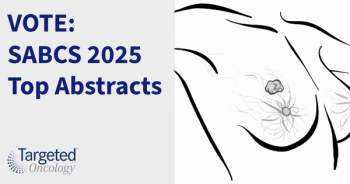
Early Activity With Ibrutinib/Venetoclax Hints New Option in R/R Follicular Lymphoma
Ibrutinib in combination with venetoclax displayed preliminary anti-tumor activity along with a tolerable toxicity profile as treatment of patients with relapsed or refractory follicular lymphoma, showing promise for the first-ever Bruton’s tyrosine kinase and BCL-2 inhibitor combination to be explored in the clinical trial setting for this patient population.
Ibrutinib (Imbruvica) in combination with venetoclax (Venclexta) displayed preliminary anti-tumor activity along with a tolerable toxicity profile as treatment of patients with relapsed or refractory follicular lymphoma (FL), showing promise for the first-ever Bruton’s tyrosine kinase (BTK) and BCL-2 inhibitor combination to be explored in the clinical trial setting for this patient population. Findings from the phase 1b portion of this multi-institutional investigator-initiated trial were recently published in Blood.
The analysis included 16 patients who were previously treated with a median of 2 prior lines of therapy (range, 1-8). Nineteen percent of patients assessed were refractory to their most recent therapy. Information collected at baseline showed that the population was a median of 66 years (range, 50-87). The majority of the population was male (75%), with stage III/IV disease (75%). A large proportion of the patients (94%) had a World Health Organization grade 1 or 2 FL. The FL International Prognostic Index (FLIPI) score was evaluated at baseline and showed that 25% were low risk, 44% were intermediate risk, and 31% were high risk. Two of the patients enrolled were considered to be at high risk for the development of tumor lysis syndrome (TLS).
As key primary end points, the study assessed the combination of ibrutinib and venetoclax to determine the recommended phase 2 dose (RP2D) based on the maximum dose tolerated by patients, as well as the response rate of the combination compared with the 30% historical response rate for individual therapies available as treatment of relapsed/refractory FL. The secondary end points were the pharmacokinetics of ibrutinib and venetoclax individually, and the number of patients who experience treatment-related adverse events (AEs) assessed at each dose level explored in the study.
At dose level (DL) 0, patients received 420 mg of ibrutinib with 400 mg of venetoclax. In the DL 1 cohort, ibrutinib was administered at 560mg with venetoclax at 400 mg. In the DL 2 cohort, patients were given ibrutinib 560mg with venetoclax 600 mg, and in the DL 3 cohort, patients received ibrutinib 560 mg in combination with venetoclax 600 mg.
Assessment of the key primary end point revealed only 1 dose-limiting toxicity (DLT) associated with ibrutinib plus venetoclax, which was grade 3 neutropenia with fever and infection at DL1. No additional DLTs were observed in the study and RP2D was set at 560 mg for ibrutinib and 600 mg for venetoclax.
The overall response rate (ORR) observed with the BTK/BCL-2 inhibitor combination was 69% (0.413, 0.890) in the overall study population, which included complete responses (CRs) in 25% of patients. Among patients who received the RP2D of the combination, the ORR was higher at 83%, with CRs observed in 33% of patients. Responses were also good at the DL2 cohort with a 67% ORR and 33% CR.
Notably, activity was also observed with ibrutinib/venetoclax in the bone marrow in 2 patients. One of the patients a large decrease from 60% to 0.5% according to flow cytometry.
Response to therapy was also assessed according to the number of prior lines of therapy patients had. Those with 1 prior line had a response rate of 86%. Patients with 2 prior lines of therapy had a response rate of 56%. By the time the first collection of data was assessed in the study, 91% of the study population had demonstrated response to therapy.
Progression-free survival (PFS) was evaluated in this analysis and showed a median PFS of 8.3 months (5.6 months to not available).
The safety analysis showed grade 3 AE, which included neutropenia (25%), thrombocytopenia (13%), lung infection (13%), upper respiratory infection (6%), neutropenic fever (6%), atrial fibrillation (6%), alanine aminotransferase/aspartate aminotransferase elevations (6%), mucositis (6%), failure to thrive in the setting of progression (6%), abdominal pain (6%). No grade 4 or 5 AEs were observed in the study. Grade 1/2 AEs were seen in > 20 of the patients population, which included diarrhea (75%), nausea (63%), bruising (38%), rash (31%), headache (31%), constipation (25%), fatigue (25%). No TLS of any grade was observed, but hyperuricemia was seen in 19% of patients. No treatment discontinuations occurred as a result of toxicity.
The results from this ongoing study show ibrutinib in combination with venetoclax may be an effective treatment option for patients with relapsed/refractory FL. The treatment strategy overall could provide a distinct alternative to the methods of treatment currently available to these patients.
References:
Ujjani CS, Lai C, Leslie LA, et al. Ibrutinib and venetoclax in relapsed and refractory follicular lymphoma. Blood. 2020; 136 (Supplement 1): 46–47. doi: 10.1182/blood-2020-136219









































